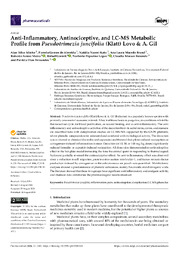Anti-inflammatory, antinociceptive, and LC-MS metabolic profile from Pseudotrimezia juncifolia (Klatt) Lovo & A. Gil.
Anti-inflammatory, antinociceptive, and LC-MS metabolic profile from Pseudotrimezia juncifolia (Klatt) Lovo & A. Gil.
Author(s): MINHO, A. S.; ALMEIDA, P. G. de; KATO, N. N.; BRAND, A. L. M.; VIEIRA, R. F.; GARRETT, R.; LOPES, N. P.; REZENDE, C. M.; FERNANDES, P. D.
Summary: Pseudotrimezia juncifolia (Klatt) Lovo & A. Gil (Iridaceae) is a popularly known species with primarily ornamental economic interest. It has traditional uses as purgative, in conditions related to the menstrual cycle, for blood purification, as wound healing, and as anti-inflammatory. The anti-inflammatory and antinociceptive activities of the decoction from its aerial stems, corms, and stamens are described here with dereplication studies on LC-MS/MS supported by the GNPS platform, where phenolic compounds were annotated and correlated with its biological activity. The decoction was evaluated in chemical (formalin and capsaicin) and thermal (hot plate) induced nociception or carrageenan-induced inflammation in mice. Decoction (at 10, 30, or 100 mg/kg doses) significantly reduced formalin- or capsaicin-induced nociception. All doses also demonstrated an antinociceptive effect in the hot plate model increasing the time the animal spent in responding to thermal signal. Naloxone partially reversed the antinociceptive effect. An anti-inflammatory effect was observed since a reduction in cell migration, protein extravasation interleukin-1, and tumor necrosis factor production induced by carrageenan in the subcutaneous air pouch was quantified. Metabolomic analyses showed a predominance of phenolic substances, mainly flavonoids and chlorogenic acids. The literature showed that these two groups have significant anti-inflammatory and analgesic activity, and chemical data corroborate the pharmacological results observed.
Publication year: 2024
Types of publication: Journal article
Keywords: Antinociception, Dereplication, Inflammation, LC-MS, Pain, Phenolics, Pseudotrimezia juncifolia
Observation
Some of Embrapa's publications are published as ePub files. To read them, use or download one of the following free software options to your computer or mobile device. Android: Google Play Books; IOS: iBooks; Windows and Linux: Calibre.
Access other publications
Access the Agricultural Research Database (BDPA) to consult Embrapa's full library collection and records.
Visit Embrapa Bookstore to purchase books and other publications sold by Embrapa.

